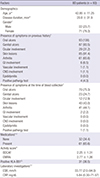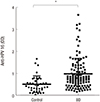1. James DG. Behcet’s syndrome. N Engl J Med. 1979; 301:431–432.
2. La Regina M, Gasparyan AY, Orlandini F, Prisco D. Behçet’s disease as a model of venous thrombosis. Open Cardiovasc Med J. 2010; 4:71–77.
3. Arnheim-Dahlström L, Pasternak B, Svanström H, Sparén P, Hviid A. Autoimmune, neurological, and venous thromboembolic adverse events after immunisation of adolescent girls with quadrivalent human papillomavirus vaccine in Denmark and Sweden: cohort study. BMJ. 2013; 347:oct09 4. f5906.
4. Kim DY, Choi MJ, Kim HY, Cho S, Cho SB, Bang D. Development and validation of an electronic medical record-based disease activity index for Behçet’s disease. Clin Exp Rheumatol. 2014; 32:Suppl 84. S40–4.
5. Kim HJ, Kim SY, Lim SJ, Kim JY, Lee SJ, Kim HJ. One-step chromatographic purification of human papillomavirus type 16 L1 protein from Saccharomyces cerevisiae. Protein Expr Purif. 2010; 70:68–74.
6. Mat MC, Sevim A, Fresko I, Tüzün Y. Behçet’s disease as a systemic disease. Clin Dermatol. 2014; 32:435–442.
7. Takeuchi M, Kastner DL, Remmers EF. The immunogenetics of Behçet’s disease: A comprehensive review. J Autoimmun. 2015; 64:137–148.
8. Kaneko F, Oyama N, Nishibu A. Streptococcal infection in the pathogenesis of Behçet’s disease and clinical effects of minocycline on the disease symptoms. Yonsei Med J. 1997; 38:444–454.
9. Kaneko F, Oyama N, Yanagihori H, Isogai E, Yokota K, Oguma K. The role of streptococcal hypersensitivity in the pathogenesis of Behçet’s Disease. Eur J Dermatol. 2008; 18:489–498.
10. Cho SB, Zheng Z, Ahn KJ, Choi MJ, Cho S, Kim DY, Lee HS, Bang D. Serum IgA reactivity against GroEL of Streptococcus sanguinis and human heterogeneous nuclear ribonucleoprotein A2/B1 in patients with Behçet disease. Br J Dermatol. 2013; 168:977–983.
11. Cho SB, Zheng Z, Cho S, Ahn KJ, Choi MJ, Kim DY, Lee KH, Bang D. Both the sera of patients with Behçet’s disease and Streptococcus sanguis stimulate membrane expression of hnRNP A2/B1 in endothelial cells. Scand J Rheumatol. 2013; 42:241–246.
12. Hatemi G, Yazici H. Behçet’s syndrome and micro-organisms. Best Pract Res Clin Rheumatol. 2011; 25:389–406.
13. Studd M, McCance DJ, Lehner T. Detection of HSV-1 DNA in patients with Behçet’s syndrome and in patients with recurrent oral ulcers by the polymerase chain reaction. J Med Microbiol. 1991; 34:39–43.
14. Lee S, Bang D, Cho YH, Lee ES, Sohn S. Polymerase chain reaction reveals herpes simplex virus DNA in saliva of patients with Behçet’s disease. Arch Dermatol Res. 1996; 288:179–183.
15. Sohn S, Lee ES, Bang D, Lee S. Behçet’s disease-like symptoms induced by the Herpes simplex virus in ICR mice. Eur J Dermatol. 1998; 8:21–23.
16. Sohn S, Lee ES, Bang D. Learning from HSV-infected mice as a model of Behçet’s disease. Clin Exp Rheumatol. 2012; 30:Suppl 72. S96–103.
17. Sohn S, Bang D, Lee ES, Kwon HJ, Lee SI, Lee S. Experimental studies on the antiviral agent famciclovir in Behçet’s disease symptoms in ICR mice. Br J Dermatol. 2001; 145:799–804.
18. Tomljenovic L, Shaw CA. Death after quadrivalent human papillomavirus (HPV) vaccination: causal or coincidental. Pharm Reg Affairs. 2012; S12:001.
19. Lee SH. Detection of human papillomavirus L1 gene DNA fragments in postmortem blood and spleen after Gardasil® vaccination: a case report. Adv Biosci Biotechnol. 2012; 3:1214–1224.
20. Gonçalves AK, Machado PR, de Souza LC, Costa AP, Gimenes F, Consolaro ML, Crispim JO, Eleutério J Jr, Giraldo PC. Detection of immunoglobulin IgA and IgG against human papilloma virus. Viral Immunol. 2014; 27:471–477.









 PDF
PDF ePub
ePub Citation
Citation Print
Print



 XML Download
XML Download